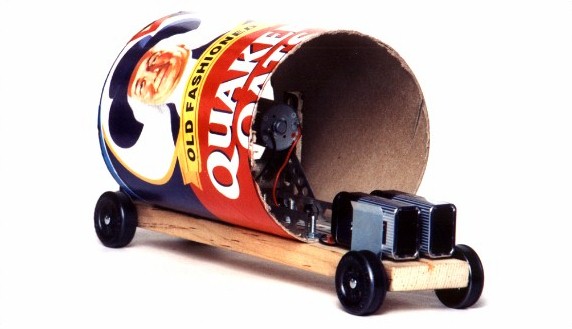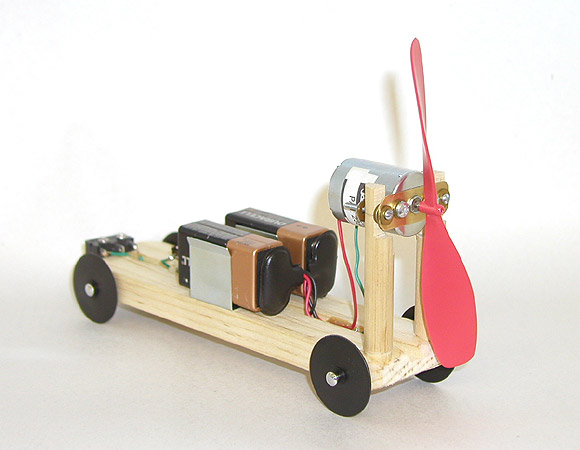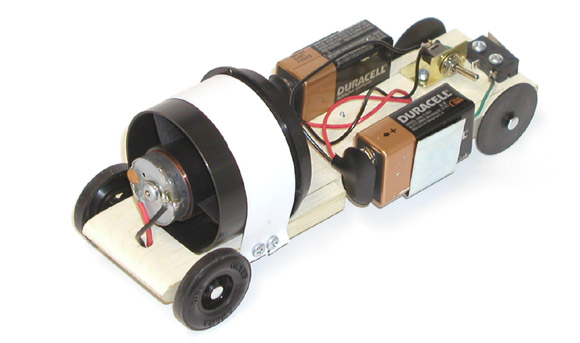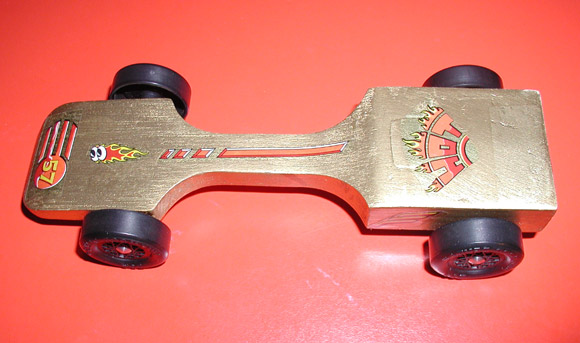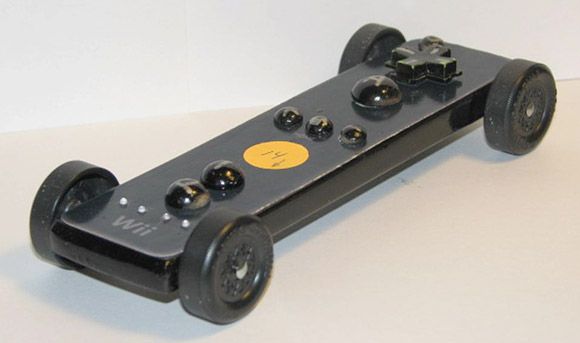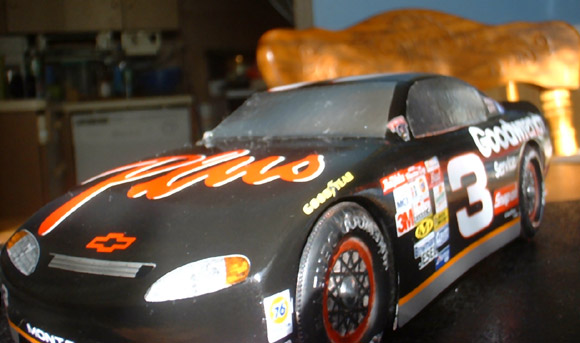– Feature Article – Top Fuel Cars: Propeller Car
– Pinewood Derby Car Showcase
– Memory – Sad Day for the True Cub Scout Boys
– Q&A
Top Fuel Cars: Propeller Car
(The third in a series of articles on cars that ‘stretch the rules’ – this is an updated version of an article that first appeared in Volume 3, Issue 5, November 26, 2003)
Many organizations give parents and siblings an opportunity to race by sponsoring an open competition race. Typically the rules for these races are somewhat relaxed, allowing more innovation and creativity in car design.
In today’s article I would like to first share some typical ways to ‘open-up’ the rules for this type of race. Then I would like to explore a more radical way to add excitement to your derby event.
Rules For Open Competition Races
Here are some common ways to allow more flexibility in open competitions:
- Wheelbase – If the organization event mandates the use of a standard wheelbase (distance between the front and back axles) then allow the wheelbase to be modified as desired, as long as the overall length specification is maintained.
- Alternate axles – Instead of requiring the use of the organization standard axles, allow the use of after-market ‘speed axles’.
- Wheel shape – Typically, standard rules allow minimal wheel modification (e.g., only a light sanding). Try removing this restriction, allowing any plastic wheel, as well as any wheel treatment including narrowed, grooved tread surface, and/or overall weight reduction.
- Length – Try changing the maximum length from the typical seven inches to twelve inches (or one inch less than the distance from the starting pin to the back edge of the track).
- Weight – Consider changing the maximum weight to one or more pounds (with standard wheels and axles, I don’t recommend exceeding 1 pound).
A More Radical Approach
Wouldn’t it be fun to add a whole new dimension to your open competition? I’m thinking power!
Okay, I know what you’re thinking. Someone will strap a rocket engine on the car, and the car will damage the track, a person, or the building! But of course, restrictions would be necessary to minimize any risk. So, I suggest the following rules.
Rules for a Radical Open Competition
Dimensions
(Adjust to fit your track, and leave an open lane between cars)
- 11 inches maximum length
- 5 inches maximum width
- No limit on height (remove the electronic finish line)
- 3 inches maximum inside wheel base
- 3/8 inch minimum track clearance
- 16 ounces maximum weight
Power Sources
In addition to gravity power, other power sources may be used as long as they do not pose a risk to the spectators or to the track.
- Allowed power sources include, but are not limited to electrical, mechanical, and pneumatic.
- Power sources which use combustion of any type are explicitly disallowed. This includes combustion engines, rocket engines, and explosives.
Wheels, Axles and Body
A pinewood derby kit may be used, but it is not required. Any material can be used for the car as long as the finished product meets the specifications. However, the wheels must be made of a material that will not damage the track. Metal, ceramic, glass, or other hard substances may not be used for wheels. Allowable materials include plastic, rubber, and wood.
Race Procedure
The owner of each car will stage the car on the starting line, and pick the car up at the end of the run. Cars may be adjusted between races as long as the adjustment does not delay the race. However, cars may not be lubricated during the race.
Possible Designs
I have heard of all sorts of ideas for adding power to pinewood derby cars. Listed below are a few that have merit.
Powered Rear Axle
- Spring wind-up mechanism
- Rubber-band powered
- Mouse-trap powered
- Electric motor powered (R/C type)
- Weight powered (suspended weight drops and turns rear axle)
All of these ideas can be made to work. But two problems must be worked out:
- How to apply power when the starting pin drops, or
- If power is applied before the pin drops, how to apply the maximum torque without the wheels spinning-out.
Non-powered Rear Axle
The design ideas below eliminate problem number two above, but problem number one must still be resolved.
- Compressed CO2 or Air (acts like a ‘jet’ engine)
- Propeller powered (push or pull)
Propeller Power
I have had some experience with propeller power, so I would like to share the design of three cars that I have built. The first one was built in 2002, the second in 2005, and the third in 2007. I have also included photos of a few propeller cars submitted by readers.
First, here are some principles that I have learned through experience.
- Maximize thrust through higher RPM motors, steeper blade pitch, and larger props.
- Maximize acceleration by minimizing weight. This mainly means lighter weight batteries.
- The longer the track, the greater the speed (and the larger the advantage over conventional cars).
My First Propeller Car
Please don’t laugh too hard; I severely over-engineered this car. But I can say the car has never had to be repaired! This car smoked the competition when it raced in 2002, and it easily beats any standard pinewood derby car (2.7 seconds on a track measuring 33 feet, 3 inches from the starting pin to the finish line – measured with a stop watch as it doesn’t fit under the finish line bridge).
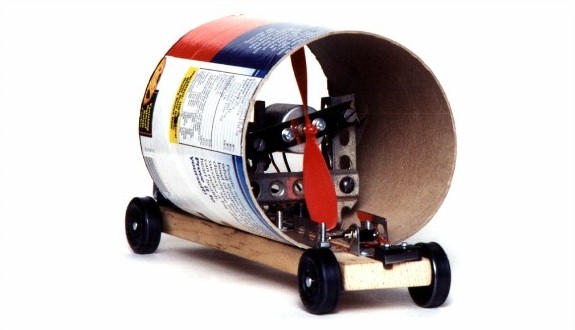
First Car – Rear View
Here is a parts list and some notes on implementation.
- Motor: 12 VDC motor, RF-370CA by Mabuchi Motors. This is a VCR motor, but other motors would work as well. I drove the motor at 18V for more power. This would eventually burn out the motor, but the on-time is so short that the motor doesn’t get a chance to overheat.
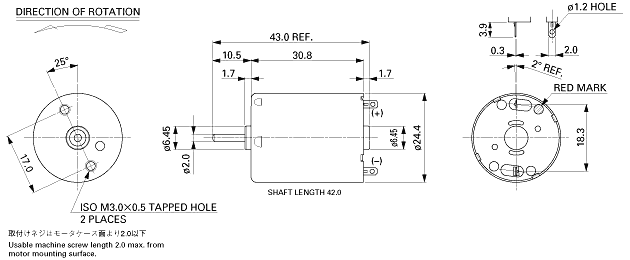
- Motor Mounting: The two screw holes on the front of the motor are for mounting. The required ISO screws can be purchased at a hardware store. I used a piece of thin stainless steel (hardware store item), drilled holes for the mounting screws, shaft, and assembly bolts (see front view picture).
- Propeller: I used a plastic prop intended for rubber band powered airplanes. The hobby store I visited sold them in packs of three. The prop is about 5 inches long, and I had to trim the tips a bit for clearance. The shaft hole was too small, so I drilled it out to fit snuggly on the motor shaft. I then used epoxy to glue it in place. I believe this type of propeller works better than an R/C airplane propeller. R/C propellers are heavier, and the blade angle is smaller, providing less thrust.
- Infrastructure: I had access to an old erector set, but you can use any light metal strapping. It does need to be securely mounted as some torque is generated. Make sure there is clearance for the propeller. I had to remove some metal from the erector material. If you look carefully at the front view, you can see where it was removed.
- Motor Shroud: Quaker Oats oatmeal container. I put this on for two reasons: (1) To keep hands from touching the blades (it hurts, but doesn’t cut if you touch the spinning blades), and (2) To keep the blade from breaking if the car rolled over – if the blade comes off, the race if over.
- Motor Alignment: The motor does need to be pointing as straight forward as possible. Add/remove small washers where the stainless steel strap fastens to the infrastructure to adjust alignment.
- Starting Pin Switch: I used a contact switch (part #275-016 at Radio Shack). It is normally on. When the car rests against the starting pin, the weight of the car closes the switch turning the motor off. Thus, when the pin drops, away it goes.
- Kill Switch: If you look carefully at the front view you will see a small toggle switch (part #275-624 at Radio Shack) that is used to turn the motor off when not in use. Just make sure to turn it on at the starting gate!
- Batteries and Holders: Two standard 9V batteries. The battery holders are Radio Shack part #275-326.
- Wiring: Light gauge electronics wire. Positive side of the battery goes to the Kill Switch, then to the Starting Pin Switch, then to the motor. The negative wire goes to the motor. Batteries are wired in series.
- Wood: Pine, 1-3/4 inches wide. The car is 10 inches long, but it could be shortened.
- Wheels/axles: Standard BSA issue. Axle holes are drilled with a drill press. All four wheels touch the ground.
My Second Car
After seeing the propeller cars built by others, I decided to build another car. This one would be less bulky, but would use the same basic components. The main differences are the use of Outlaw Wheels, the full 5 inch long propeller (did not need to be shortened), and significant weight reduction.
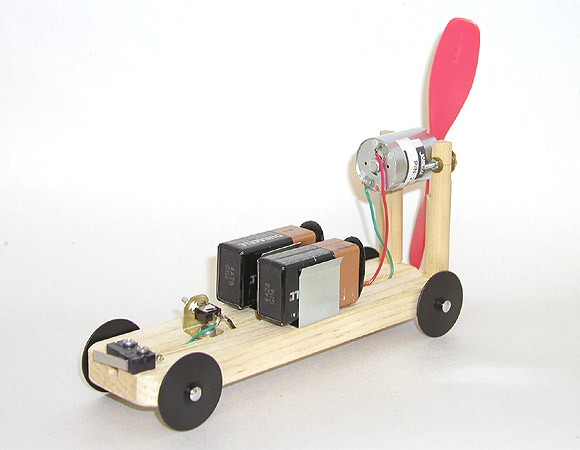
Second Car – Rear View
With the reduced weight the performance improved significantly, completing the same distance as prop car 1 in 2.2 seconds, 1/2 second faster than my first car (again measured with a stopwatch). But remember the reason for the oatmeal container on the first car? Sure enough, on the second run, the car tipped over on the braking section, and the propeller flew off. So the lesson is that if you run this type of car, keep the finish line area clear of people (to avoid an eye injury), and have someone stationed at the end to catch the car and turn off the motor.
My Third Car
I decided I needed to build a car that fit within the standard dimensions, so that it would go under the finish line bridge. After a reader posted some information on a derby forum, I decided to do this with a ducted fan from an R/C ‘Jet’ plane (purchased from Hobby Lobby). To get a high enough RPM, I used a 7.2 V Speed 300 compatible motor that was intended for an R/C boat. The motor is powered at 9 volts. The two batteries are wired in parallel to provide enough current for the motor.
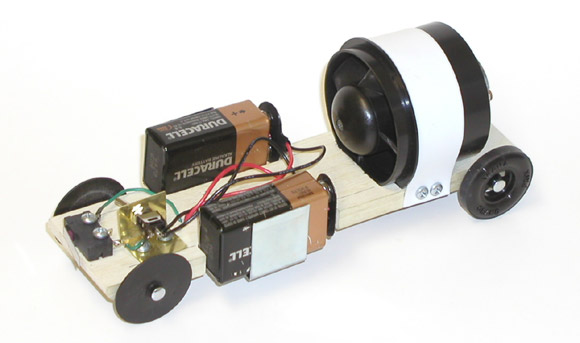
Third Car – Rear View
This car is loud and fast, but not quite as fast as the second car. It runs the same course in 2.3 seconds. I believe the speed could be improved with a smooth ring around the intake (like on a real jet engine). According to the documentation that came with the duct fan, this can improve thrust by as much as 25 percent.
Reader Submitted Cars
Here are a few propeller cars sent to me by readers.
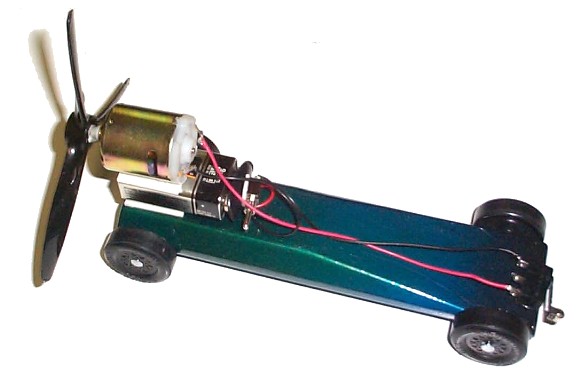
Like my car, this one has a starting pin contact switch and a kill switch. Hanging the propeller (tri-blade in this case) off the back of the car permits the use of a longer propeller.
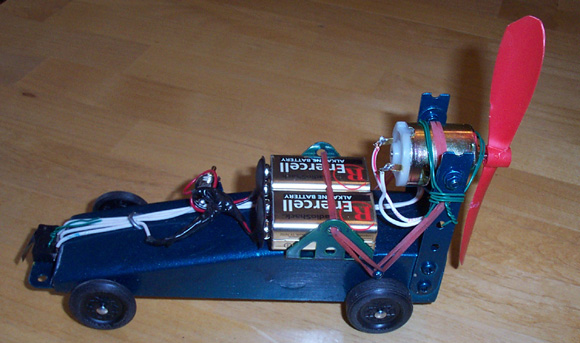
A similar design using a rubber band airplane propeller (and liberal use of rubber bands in the infrastructure).
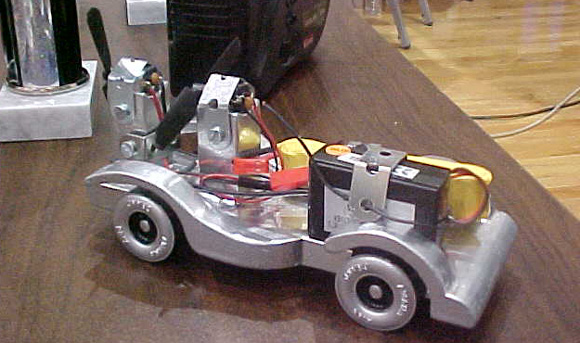
A dual prop model that uses an R/C type battery and control. It appears to be quite heavy, so I am not sure how will it performed. (This photo was sent to me by another participant in the race. If this is your car, please let me know so that I can give you credit).
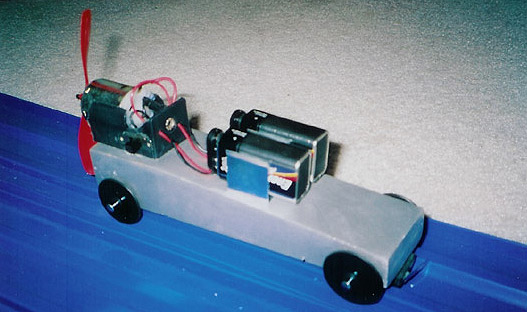
(If this is your car, please let me know so that I can give you credit).
Conclusion
Maybe this all seems a bit ridiculous to you. But I guarantee that if you have a group with a lot of handy parents, an open competition race with power assist is a blast and a certain crowd pleaser!
Pinewood Derby Car Showcase
Low-Rider: Paul & Jordan Messineo
Jordan is 9 years old, and for two years he entered the Derby only to come in last each year. He went to his dad and said enough is enough; he wanted to at least be competitive. Dad enlisted grand pap and stated the problem. Papap went online and found Maximum Velocity, who helped with a lot of the details. Guess what? Jordan came in 1st out of 50 cars. That was last year, now everyone in the district was waiting for the latest entry of Jordan’s. Jordan showed up with a great running Wedge car that looked like a winner. However, the rules were modified and Jordan’s father did not receive the changes due to his out of town travels. The Wedge car had three wheels touching, and the rules clearly stated that all four wheels had to touch. When Jordan showed up with his father, one hour before the race they were told of the rule changes and the car was declared ineligible. Jordan was devastated and heartbroken. Papap and Dad went back home and decided to look at the other cars that Jordan had built to see if anything could be done. Jordan’s brothers, Paul III and Brandon, worked on this previously built Low-Rider (with Papap and Dad) to lower the fourth wheel. With only 22 minutes remaining they completed the revision and started back to the race. They arrived with only 6 minutes remaining and checked in with the revised Low-Rider. The car was carefully checked by the officials and passed.
The race started, and low and behold Jordan finished second. This was quite an accomplishment considering the work that had to be done in order to compete. Well compete they did, what a lesson in life this taught Jordan, NEVER GIVE UP!
But the story does not end here. The following week Jordan entered the Pittsburgh Council regional event with the same car and took 1st in Webelos and 2nd overall. What a great time Jordan had in telling this story – three trophies in two weeks!
Wii: Jim, Josh & Jake Heidecker </b
Josh (1st year Webelo) and Jake (Bear) had selected your Wing design for their car this year but were not sure how they were going to paint it. Both really wanted a Nintendo Wii game console for Christmas – when I mentioned that the controller for the game was about the same size as their pinewood derby cars, they got the inspiration for this design. With the help of the speed tips we learned from your site, Josh came in 1st and Jake came in 2nd out of 66 cars! The attached picture is Josh’s car; Jake’s was similar except it was white.
Dale Earnhardt’s 1998 Daytona 500 Winner: James Gravely
Last year was my son’s last year of scouting, so my last hold on pinewood derby racing is gone! I love pinewood derby racing, and am now thinking if I want to ask my wife to have more kids. My only problem is I would have to wait five years before they could join Cub Scouts and, oh my, suppose they were girls!? Well let’s just forget that idea (for now).
Anyway, while my son was in Cub Scouts, every year we came up with the most exciting concept that we could (actually I hoped my son would let me decide on the design because his were more intricate than mine, and I knew I would have great difficulty fabricating his desires).
This car is a replica of the late Dale Earnhardt’s 1998 Daytona 500 winner, complete with all the correct details. The car would have been our 2007 entry if my som was still active in Cub Scouts. I built the entire car myself with no help from my son since it was not intended to be raced. The car is built to specification and is completely legal for derby racing: correct wheels, axles, weight, and size dimensions. The car is bathed in ‘Racer Black’ lacquer, and the decals and paint are protected by five coats of clear gloss top coat.
Pinewood Derby Memory
Sad Day for the True Cub Scout Boys
Every year my brother would get help on his car from the “winning family”, but for some reason his car never placed. This year we decided to try someone different – help from a friend that has helped build winning cars for his nephews and grand-kids.
It was a great race. My son, who is a Wolf, and my brother, who is a Webelo II, had two of the fastest cars there. My son took first in his den, while my brother took first in his. The final race was with the first place cars from each den.
It ended up being my son’s car racing my brother’s car. The people putting the cars on the track sent my brother’s car down crooked. My son’s car won that race and got the trophy, but I asked the Cubmaster to re-race the cars because my son needed to know that he won fair and square.
In the second race my brother’s car won. They raced the cars two more times in different lanes, but my brother’s car won every time.
Then the sad event occurred. The “winning family”, whose cars did not win this year, were angry because their cars would not being going to the district race. They confronted the Cubmaster who told them that nothing could be done. The parent then replied, “I don’t know how I am going to keep my boy in Cub Scouts anymore.” But that was not the end of it. They tried to talk other people out of taking their car to districts, so that their son’s car could go. But the Cubmaster put an end to that.
It is sad to think that the biggest event in Cub Scouts had become the only event for this family. The pinewood derby is supposed to teach sportsmanship and be fun, but now it seems to have become a competition that teaches “win or whine”.
Cora Brandon
Editor’s Note: Please do yourself and your children a favor; remember that the pinewood derby is intended to be a friendly competition that is fun for the kids. An improper attitude will only serve to sour the experience for yourself, your children, and other participants.
Q&A
Do you sell – or know where to get – the old style BSA wheels? I’ve got an old car from about 1972 that has a cracked wheel. The wheels are like the ones on the Don Murphy and Craig Breedlove signature cars in Volume 6, Issue 14.
Beta Crafts is still making the kit, but they appear to only sell then in quantity lots. See: www.betacrafts.com
What is the best way to clean graphite overspray off the car?
There is no sure way to remove graphite, but here are several methods that people have had success with:
- Rubber pencil eraser
- Vegetable oil on a soft rag
- Liquid dish soap on a soft rag
- Auto cleaner wax on a soft rag (e.g., Meguiar’s No. 6 Cleaner Wax)
- WD-40 on Q-tip, then use a good paste wax
- Pledge wipes
I’ve got a car that I’m trying to align. I have a left front wheel that’s just barely raised (makes contact occasionally). The car tracks 1 inch to the right over a test of 6 feet. It’s my opinion that I’d gain more from a car that’s perfectly straight running, than I would from only 3 wheels making contact with the track. Putting a premium on alignment instead of the reduced friction of 3 wheel contact, do you share this opinion?
I would continue with 3 wheels, but then make an adjustment to the steering wheel to get the car to drift towards the raised wheel. First, make sure that the raised wheel doesn’t touch. The main advantage of the raised wheel is that it doesn’t rob energy by spinning up. If it touches at all, there is no benefit. The drift towards the raised wheel is to make sure it doesn’t contact the center guide rail.
Next, make sure that the test ramp is dead level left-right, and slightly pitched downhill. Use a bubble level, or a ‘steely’ marble (roll it down the track to see if it deviates).
Final adjust the steering. You will need a slight bent axle for the front steering wheel. I recommend a drift of 5 inches over 8 feet.
Want Answers?
Do you have a pinewood derby-related question? If so, e-mail us your question.We answer all questions by e-mail, but not every question will appear in the Q&A section of the newsletter.
Back Issues
Are you a new subscriber, or have you missed some of the previous newsletters? Don’t miss out; all of the issues for Volume 5 through Volume 17 are posted on our web site.
Newsletter Contributions
We welcome your contributions. If you would like to contribute an article, a web site review, a speed tip, or a pinewood derby memory, please e-mail us.
Subscription Information
The Pinewood Derby Times is a free e-newsletter focused on pinewood derby racing. It is published biweekly from October through March.
If you haven’t already done so, please forward this issue to your pinewood derby friends. But please don’t subscribe your friends. Let them decide for themselves. Thanks.
If this newsletter was forwarded to you, why not subscribe to receive this newsletter. There is no cost, and your e-mail address is safe, as we never sell or share our distribution list.
To subscribe, send a blank e-mail to
[email protected]
You will receive a confirmation e-mail. Reply to the confirmation e-mail and you will start receiving the Pinewood Derby Times with the next issue.
Randy Davis, Editor, Pinewood Derby Times
E-Mail: [email protected]
(C)2018, Maximum Velocity, Inc. All rights reserved. Please do not reprint or place this newsletter on your web site without explicit permission. However, if you like this newsletter we grant permission, and encourage you to e-mail it to a friend.
Maximum Velocity disclaims any personal loss or liability caused by utilization of any information presented in this newsletter.
The Pinewood Derby Times is not specific to, and is not affiliated with the Boy Scouts of America, YMCA, Awana, or any other organization.
(R)Maximum Velocity is a registered trademark of Maximum Velocity, Inc.
(R)Pinewood Derby is a registered trademarks of the Boys Scouts of America.
(R)Awana is a registered trademark of Awana Clubs International.
All other names are trademarks of their respective owners.

